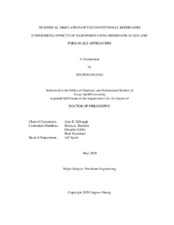| dc.description.abstract | Difficulties have been encountered in modelling unconventional reservoirs using traditional approaches. One of the reasons causing the failure is that the mechanisms of fluid flow, phase change etc. in nanopores have not been thoroughly investigated and understood. To study effects of nanopores, in this study, we use both reservoir-scale and pore-scale approaches which could help understand the physics of fluids in nanopores from different levels.
At reservoir scale, effects of distribution of nanopores are first studied. To incorporate pore size distribution into reservoir simulation, multi-porosity model is applied to divide shale matrix into different continua based on experimental data. Then phase behavior in different kind of pores is considered by coupling capillary pressure into vapor-liquid equilibrium of the compositional simulator. Besides, production from mixed-wet shale reservoir is studied. Mixed-wettability is modeled explicitly by dividing shale matrix into organic matter and inorganic matter. To construct relative permeability for three-phase flow, interaction between water and oil is simulated by directly performing immiscible displacement on digital rocks; relative permeability of oil and gas is obtained from calculated capillary pressure curve. Then, CO2 injection into shale reservoir is evaluated for both enhanced gas recovery and permeant CO2 sequestration. The dispersed nature of kerogen is characterized and its effects are comprehensively. Critical factors during CO2 injection are evaluated including total organic carbon, injection rate and diffusion coefficient etc.
At pore-scale, a pseudo-potential lattice Boltzmann model is extended to study the phase equilibrium in nanopores. The interaction force between molecules in pseudo-potential model is associated with equation of state. The proposed model is validated by comparing equilibrium densities and saturation pressures with predictions from Maxwell construction and equation of state. Simulated interfacial tensions are found consistent with Young-Laplace equation and parachor model. The model is then applied to study the phase change under effects of interface curvature. The deviations of phase equilibrium caused by curved interface curvature is characterized by Kelvin equation. Besides, the length scales of pseudo-potential model for simulating different fluids are determined quantitatively by non-dimensionalizing the interfacial tensions. The length of the lattice spacing in pseudo-potential model is found on the order of a few angstroms due to its interfacial properties. | en |


